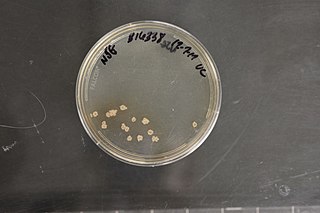
The Pseudonocardiaceae are a family of bacteria in the order Actinomycetales and the only member of the suborder Pseudonocardineae.
Streptomyces atriruber is a bacterium species from the genus Streptomyces which has been isolated from an equine placenta in Lexington in Kentucky in the United States.
Granulicoccus phenolivorans is a Gram-positive and phenol-degrading bacterium which has been isolated from phenolic wastewater in Singapore.

Allokutzneria is a genus from the family Pseudonocardiaceae.
Allokutzneria multivorans is a bacterium from the genus Allokutzneria which has been isolated from soil from a river bank from the Nujiang River in Yunnan, China.
Allokutzneria oryzae is a bacterium from the genus Allokutzneria which has been isolated from the rhizospheric soil from the rice-plant.
Goodfellowiella coeruleoviolacea is a bacterium from the family Pseudonocardiaceae which has been isolated from soil in Russia.
Kibdelosporangium is a Gram-positive genus from the family of Pseudonocardiaceae. Kibdelosporangium bacteria produce substances with antibacterial, anticancer, and antiviral activities.
Kibdelosporangium metalli is a Gram-positive bacterium from the genus Kibdelosporangium which has been isolated from an earth mine in Bayan Obo, China.
Lentzea is a Gram-positive, mesophilic and aerobic genus from the family Pseudonocardiaceae.
Lentzea kentuckyensis is a bacterium from the genus Lentzea which has been isolated from a placenta of an Equine in Lexington.
Lentzea californiensis is a bacterium from the genus Lentzea which has been isolated from soil in California.
Clostridium bowmanii is a psychrophilic, Gram-positive, anaerobic and spore-forming bacterium from the genus Clostridium.
Clostridium frigoris is a Gram-positive, rod-shaped, and spore-forming bacterium from the genus Clostridium. It is a psychrophile, with optimal growth conditions at 5–7 °C.
Streptomyces odonnellii is a bacterium species from the genus of Streptomyces which has been isolated from soil from Brazil.
Glycomyces algeriensis is a bacterium from the genus of Glycomyces which has been isolated from soil from a potato field in Algeria.
Glycomyces arizonensis is a bacterium from the genus of Glycomyces which has been isolated from soil from a kangaroo rat burrow from Arizona in the United States.

Stackebrandtia is a Gram-positive, aerobic and non-motile genus of bacteria from the family of Glycomycetaceae. Stackebrandtia is named after the German microbiologist Erko Stackebrandt.

Stackebrandtia nassauensis is a bacterium from the genus of Stackebrandtia which has been isolated from soil from a roadside from Nassau in Puerto Rico.
Sneathiella chinensis is a Gram-negative, aerobic, non-spore-forming, chemoheterotrophic, halotolerant and motile bacterium from the genus of Sneathiella which has been isolated from coastal sediments from Qingdao in China.



